Will Jake Virtanen Start the Season in the AHL?
By J.D. Burke
7 years ago
Anne-Marie Sorvin: USA Today Sports
The Canucks have a series of difficult questions to face at the onset of training camp. Paramount among them is whether they can accommodate Jake Virtanen as a feature on their opening night lineup.
It’s not even a matter of regression, or whether Virtanen has done anything to loosen his grip on a full-time job. By all accounts, Virtanen had one of the best second halves among all Canucks’ forwards; a distinction worth making, but one that perhaps undersells his body of work last season as a whole, truthfully. He’s apparently been putting in serious work this off-season, too.
What’s at work here is a set of logistical hurdles the Canucks set for themselves with the additions of Loui Eriksson and Anton Rodin — and there’s also a healthy Brandon Sutter to consider. That’s effectively three new forwards in a group that could’ve maybe supported the addition of two at no cost to the retained members of yesteryear’s lineup.
All told, the Canucks have 12 forwards either on one-way contracts, set for waiver eligibility or all but guaranteed a roster position. That leaves a 13th and final (assuming Vancouver carries two extra defencemen — a logical assumption, really) roster spot.
Now, right off the hop that’s a disadvantageous set of circumstances for Virtanen. It’s almost an unwritten rule that the 13th forward on almost any lineup is a centre, and with good reason. The transition from centre to wing is considerably easier than wing to centre. Not to mention, masking a defunct winger in your lineup is much, much easier than hiding a centre.
So while conventional wisdom suggests that Virtanen would be at odds with Brendan Gaunce for the 13th and final spot in the Canucks lineup, that’s likely not the case. The Canucks drafted Gaunce as a centre, and he’s shown himself more than capable of holding his own on the wing, too. That positional versatility is immensely valuable in a pinch — the exact type of situation where a 13th forward is most necessary.
Which leaves Virtanen in a pitched battle with eight wingers, all of which are on one-way deals; all of which are waiver eligible. Speaking strictly in the context of “asset management” the Canucks are staring down a loaded barrel.
They’ve already burnt a year of Virtanen’s ELC and docked a year towards unrestricted free agency to keep him in the lineup as an 18-year-old. Now they’re faced with the very realistic possibility that the one-way contracts ahead of him will force Virtanen from their lineup but a season later. The alternative, of course, is that they clear a bubble player like Alexandre Burrows or Derek Dorsett from their lineup to create space and suffer the consequences of losing either player for nothing, or paying them millions to ride the bus in the AHL.
It’s a damned if you, damned if you don’t type situation. If the Canucks value winning above all else, though, it’s a relatively easy one to make. You keep Virtanen in the lineup, logistics and asset management be damned.
There’s just so much Virtanen brings that is otherwise absent from this lineup. He was arguably the Canucks’ best neutral zone player last season, had the single best two-way impact at even strength and flashed just enough offensively to suggest he might one day develop into that coveted top-six power forward this club so desperately needs.

The Canucks finished with the league’s sixth-worst score and venue adjusted Corsi last season, and many of those struggles stemmed from their end of the ice. Removing the only remaining player from last season’s lineup who finished in the black by this same measure doesn’t make intuitive sense. Especially considering much of Virtanen’s two-way success is derived from a strong transitional game, as his team-leading 28 entries per 60 last season would attest.
And while the NHL career Virtanen’s built to date is much more about the little things he does right, the statistical profile of his pGPS indicates he’s on the path to developing into an impactful second-line forward that can chip in offensively, too. Virtanen’s four closest statistical and stature based comparable players through pGPS are Shane Doan, Justin Williams, David Legwand and Pavol Demitra. Based on those comparable players, it’s not unreasonable to expect some level of offensive improvement going into next season.
Vancouver just doesn’t have a large margin for error next season. The Canucks had a good off-season, this much is hardly up for debate. But given their stated goal to compete for the playoffs again, after finishing third last, it’s fair to wonder if they’ve done enough to distinguish themselves from their inter-division competitors. They made additions too after all.
So with that in mind, the Canucks would be wise to do everything in their power to either create separation or close the distant with those very same teams that they’ll be toe-to-toe with for a playoff spot next spring. Sometimes the little things add up, and it’s almost a given they can secure that much from Virtanen next season.
Recent articles from J.D. Burke





